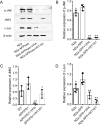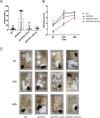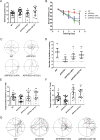Histone deacetylase inhibitors VPA and WT161 ameliorate the pathological features and cognitive impairments of the APP/PS1 Alzheimer's disease mouse model by regulating the expression of APP secretases
- PMID: 38245771
- PMCID: PMC10799458
- DOI: 10.1186/s13195-024-01384-0
Histone deacetylase inhibitors VPA and WT161 ameliorate the pathological features and cognitive impairments of the APP/PS1 Alzheimer's disease mouse model by regulating the expression of APP secretases
Abstract
Background: Alzheimer's disease (AD) is a degenerative neurological disorder. Recent studies have indicated that histone deacetylases (HDACs) are among the most prominent epigenetic therapy targets and that HDAC inhibitors have therapeutic effects on AD. Here, we identified sodium valproate (VPA), a pan-HDAC inhibitor, and WT161, a novel HDAC6 selective inhibitor, as potential therapeutic agents for AD. Underlying molecular mechanisms were investigated.
Methods: A cellular model, N2a-APPswe, was established via lentiviral infection, and the APPswe/PSEN1dE9 transgenic mouse model was employed in the study. LC-MS/MS was applied to quantify the concentration of WT161 in the mouse brain. Western blotting, immunohistochemical staining, thioflavin-S staining and ELISA were applied to detect protein expression in cells, tissues, or serum. RNA interference was utilized to knockdown the expression of specific genes in cells. The cognitive function of mice was assessed via the nest-building test, novel object recognition test and Morris water maze test.
Results: Previous studies have focused mainly on the impact of HDAC inhibitors on histone deacetylase activity. Our study discovered that VPA and WT161 can downregulate the expression of multiple HDACs, such as HDAC1 and HDAC6, in both AD cell and mouse models. Moreover, they also affect the expression of APP and APP secretases (BACE1, PSEN1, ADAM10). RNA interference and subsequent vitamin C induction further confirmed that the expression of APP and APP secretases is indeed regulated by HDAC1 and HDAC6, with the JNK pathway being the intermediate link in this regulatory process. Through the above pathways, VPA and WT161 effectively reduced Aβ deposition in both AD cell and mouse models and significantly improved cognitive function in AD mice.
Conclusions: In general, we have discovered that the HDAC6-JNK-APP secretases cascade is an important pathway for VPA and WT161 to exert their therapeutic effects on AD. Investigations into the safety and efficacy of VPA and WT161 were also conducted, providing essential preclinical evidence for assessing these two epigenetic drugs for the treatment of AD.
Keywords: Alzheimer’s disease; Aβ deposition; Cognitive function; Histone deacetylase; VPA; WT161.
© 2024. The Author(s).
Conflict of interest statement
The authors declare no competing interests.
Figures










Similar articles
-
Berberine Alleviates Amyloid-Beta Pathology in the Brain of APP/PS1 Transgenic Mice via Inhibiting β/γ-Secretases Activity and Enhancing α-Secretases.Curr Alzheimer Res. 2018;15(11):1045-1052. doi: 10.2174/1567205015666180702105740. Curr Alzheimer Res. 2018. PMID: 29962345
-
Histone acetyltransferase p300 mediates histone acetylation of PS1 and BACE1 in a cellular model of Alzheimer's disease.PLoS One. 2014 Jul 22;9(7):e103067. doi: 10.1371/journal.pone.0103067. eCollection 2014. PLoS One. 2014. PMID: 25051175 Free PMC article.
-
Folic acid deficiency enhances abeta accumulation in APP/PS1 mice brain and decreases amyloid-associated miRNAs expression.J Nutr Biochem. 2015 Dec;26(12):1502-8. doi: 10.1016/j.jnutbio.2015.07.020. Epub 2015 Aug 8. J Nutr Biochem. 2015. PMID: 26345540
-
The Swedish dilemma - the almost exclusive use of APPswe-based mouse models impedes adequate evaluation of alternative β-secretases.Biochim Biophys Acta Mol Cell Res. 2022 Mar;1869(3):119164. doi: 10.1016/j.bbamcr.2021.119164. Epub 2021 Oct 23. Biochim Biophys Acta Mol Cell Res. 2022. PMID: 34699873 Review.
-
Therapeutic potential of dual HDAC6/SIRT2 inhibition in Alzheimer's disease.Eur J Med Chem. 2025 Sep 15;294:117733. doi: 10.1016/j.ejmech.2025.117733. Epub 2025 May 9. Eur J Med Chem. 2025. PMID: 40381221 Review.
Cited by
-
Formulating Treatment to Cure Alzheimer's Dementia: Approach #2.Int J Mol Sci. 2024 Mar 20;25(6):3524. doi: 10.3390/ijms25063524. Int J Mol Sci. 2024. PMID: 38542495 Free PMC article. Review.
-
Therapeutic Options in Alzheimer's Disease: From Classic Acetylcholinesterase Inhibitors to Multi-Target Drugs with Pleiotropic Activity.Life (Basel). 2024 Nov 26;14(12):1555. doi: 10.3390/life14121555. Life (Basel). 2024. PMID: 39768263 Free PMC article.
-
Identification of JAZF1, KNOP1, and PLEKHA1 as causally associated genes and drug targets for Alzheimer's disease: a summary data-based Mendelian randomization study.Inflammopharmacology. 2024 Dec;32(6):3913-3923. doi: 10.1007/s10787-024-01583-z. Epub 2024 Oct 25. Inflammopharmacology. 2024. PMID: 39455528
-
The Promise of Epigenetic Editing for Treating Brain Disorders.Subcell Biochem. 2025;108:111-190. doi: 10.1007/978-3-031-75980-2_4. Subcell Biochem. 2025. PMID: 39820862 Review.
-
Modulating Cognition-Linked Histone Acetyltransferases (HATs) as a Therapeutic Strategy for Neurodegenerative Diseases: Recent Advances and Future Trends.Cells. 2025 Jun 10;14(12):873. doi: 10.3390/cells14120873. Cells. 2025. PMID: 40558500 Free PMC article. Review.
References
Publication types
MeSH terms
Substances
Grants and funding
LinkOut - more resources
Full Text Sources
Medical
Research Materials
Miscellaneous

